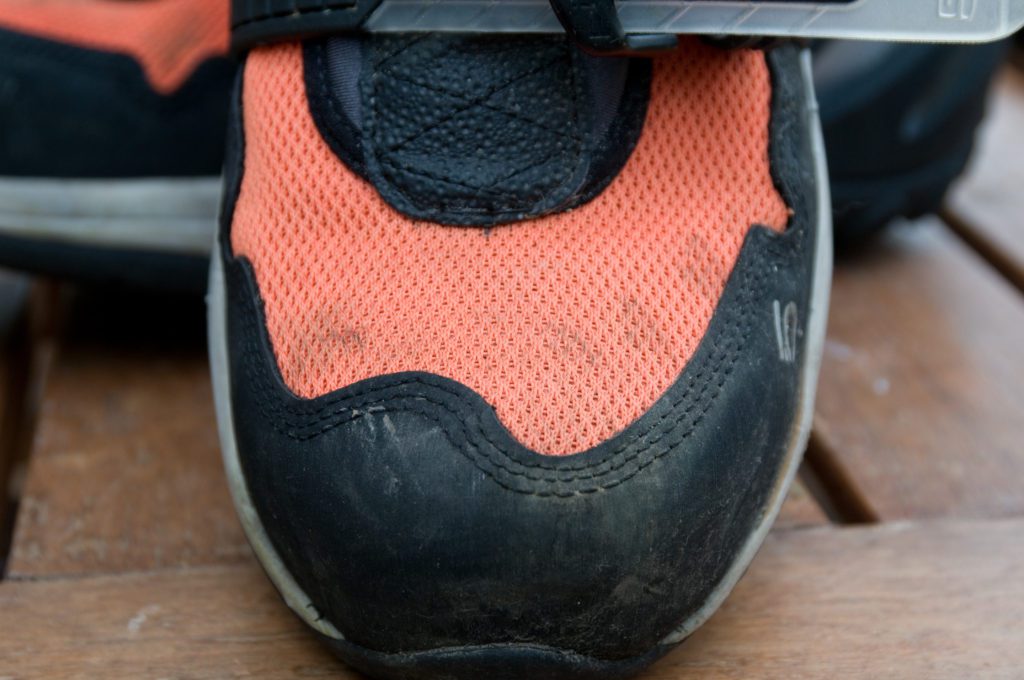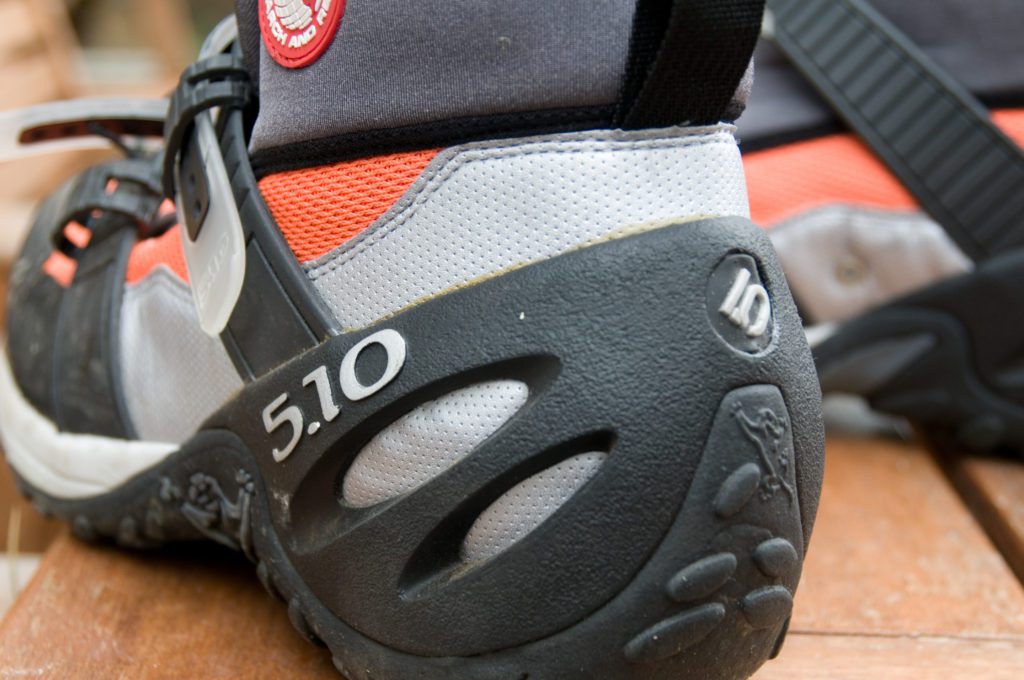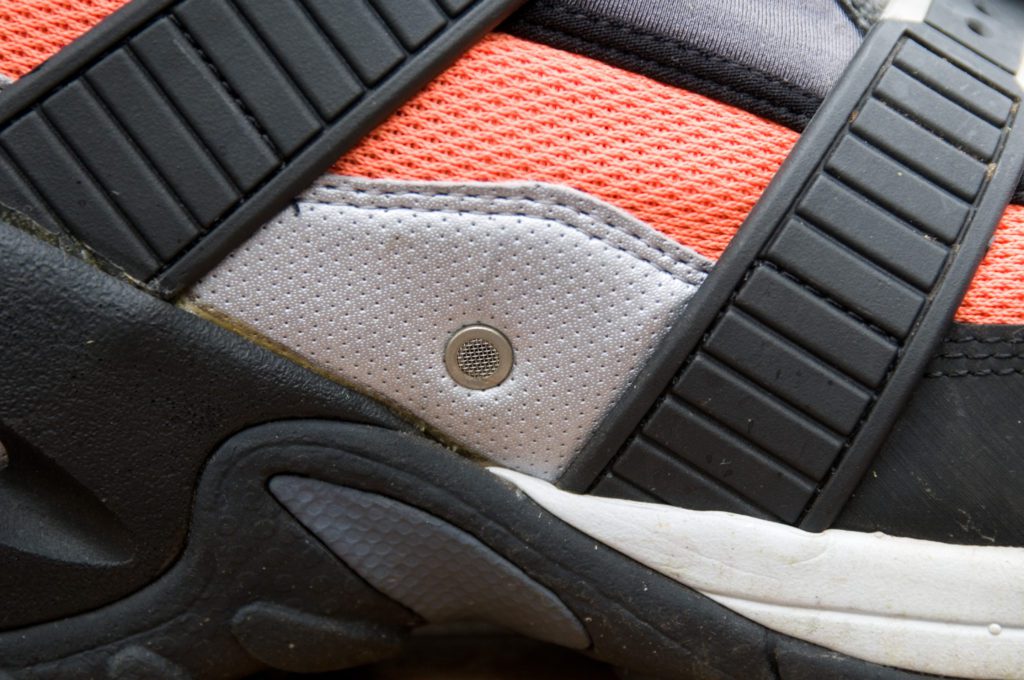UPDATE: Five Ten is no longer producing specialist canyoning footwear, and has discontinued a number of shoes including the Canyoneer SAR. The good news is there’s still plenty of great options for canyoners looking for a tough water shoe with great grip. You can see some of the other options we have reviewed here: fatcanyoners.org/reviews/.
On a trip down Carra Beanga falls, Julie Burton described her new found love of 5.10 canyoneering boots. These shoes have been designed specifically with the American canyoneering community in mind. So after the trip I began to do some research. My first reaction after seeing them was there is no frigging way I’m putting those things on my feet. With bright fluorescent colours, bulky over-the-top neoprene cuffs, and buckles which look akin to shoes I might let my five year old wear, I was instantly turned off by them.

A few weeks later, while driving from Orange to Sydney, Drew and I decided to do a quick trip down Empress Canyon. While I normally would not go near Empress on the weekend we thought it might be a fun (and hopefully) quick trip. After passing about 30 people in two commercial groups (never, never go down Empress on the weekend between 10am and 2pm) we set up the left hand side abseil while yet another commercial group finished up on the right. One of the guides was using the 5.10 Canyoneer shoe and I had a good chance to talk to her about what they were like. She praised the shoe for its durability and comfort. Another thing that struck me was that in use they really did not look that silly. After our chat Drew and I abseiled down and then sat for about half an hour at the bottom watching the commercial group members inverting on the waterfall abseil. Classic.
On the way back from Sydney we dropped into Summit Gear in Katoomba and my wife bought me a pair of for my birthday. So now I am a proud owner of the 5.10 Canyoneer SAR.
Overall impression:
According to 5.10’s website the Canyoneer shoe is designed by canyoneers, for canyoneers. For those who do not know, Australians call canyoning — wait for it — canyoning. In America they call canyoning, canyoneering. I’m not terribly sure what country (it might be the Europeans for all I know) that can call claim to be the first in this sport so I don’t know (or really care) what is should be called.
At the offset I had two choices, the Canyoneer2 and the Canyoneer SAR. I decided to choose the SAR over the normal because it appears to be the more robust of the two. Mainly I felt that on the Canyoneer2 the material over the toe guard did not extend far enough and could possibly tear or delaminate. (T2 made the opposite decision. You can read his review of the Canyoneer 2 here).


With the SAR this potential problem is fixed by extending the durable synthetic leather which extends from the toe to the first buckle. This area, the widest point of the foot, has always been one of the first points of failure with my previous canyoning shoes, so having an extended reinforced foot area was a big bonus for me.

The SAR boasts two additional features over the Canyoneer2. First is that the sole is apparently impenetrable. I’m not too sure if this is a useful feature as I don’t think I’ve ever punctured my sole before. The second feature is the non-metallic toe cap. This appears to be made from hard plastic. I can see some merit in this feature as I’ve sometimes jammed my toes while canyoning.

The sole of the Canyoneer SAR is made from a combination of Stealth S1 rubber for the main sole and Stealth C4 rubber for the inner “big toe” area. Both of these materials are apparently superior in providing excellent traction in wet environments. The C4 rubber is apparently a durable rubber used in climbing shoes.

The exterior of the toe cap, which extends from the tip of the shoe to the first buckle, appears to be made from durable synthetic leather. This material is triple-stitched to the shoe and appears to be quite robust. While in conversation with the guide in Empress, she mentioned that that the side of the Canyoneer2 tearing was a point of failure and appears to be fixed with the SAR.
The lower upper of the shoe, the orange part, is made from what appears to be a tightly woven synthetic mesh. I do not think durability will be an issue, as the fabric is very tightly woven.

The mid layer upper, which acts as an extension of the synthetic leather, appears to be a perforated vinyl like material. This silver material is sewn to the mesh layer in the front of the shoe and to the neoprene layer which makes up the heel and ankle cuff. On the inner side of the shoe, riveted to the mesh / silver vinyl is a drainage hole. Neat!

The ankle area and the heel of the shoe are made from what appears to be 3mm neoprene. The cuff is held together with one panel of Velcro. The neoprene does not only superficially cover the ankle but extends into the inner sole from the heel to the slightly past the fibula of the foot.
The buckle system consists of two robust buckles made of plastic. In the shop they were easy to adjust and provide a wide range of different adjustments levels.

The little tag inside the shoe tells me it is made in the USA.

First walk:
A few days after purchasing the SAR’s I decided to test them out at a local cave in Orange. The walk consists of a 7km round trip. The cave itself is called Tunnel Cave and follows an ephemeral stream underground for about 500m. The cave offers a variety of surfaces to test the SAR’s from smooth limestone, really wet muddy limestone and just plain wet limestone (if you fail at bridging and fall in the water). I managed to test all three conditions (sorta).
1) Smooth limestone:
I have found that smooth polished limestone, the kind you find in some over-used caves, to be a very difficult place to find a good foothold. The SAR’s preformed surprisingly well. I found that the best traction was held by the C4 rubber and the shoe responded to edging quite well.
2) Really wet muddy limestone:
This is the area I was quite surprised in the SAR’s performance. I have visited wet caves in the past wearing Volleys and to be honest they are horrible in the mud. When the Volley treat gets clogged up with mud they become useless. The SAR’s exceeded my expectation with the traction that they provided as the presence of water seemed to enhance their grip.
3) Wet Limestone:
As it was a rather cool day, and by admitting to be wet would consist of admitting at failing at bridging, I decided not to fully submerge my feet that day. I did dip the soles into the water and test them. The traction was quite good against the limestone, and again, the SAR responded to wet with improved grip.
As for comfort I found the SAR comfortable enough. The shoe did feel a bit stiff but I am not sure if that is because I was breaking them in. I did feel like I was walking in a boot, but then again, I was walking in a boot. I did take into account that I normally walk in Volleys or a pair of Keen walking shoes so this is something that did not bother me.
Hole in the Wall Canyon:
Over the weekend I decided to head up to the mountains and test out the SAR in Hole in the Wall canyon. I had a few questions in mind before I started my trip about the SAR and its performance.
1) Walk in and walk out comfort:
I found the SAR to be quite comfortable in the approach to the canyon. Come to think about it I never really thought about the shoes during the walk in. The walk out on the other hand was quite comfortable. I’ve found in the past that the walk out of Hole in the Wall can be a bit tiresome with Volleys. For most of the last few kilometers the fire trail gets a bit rocky. The SARs provided a comfortable supportive walk out. I also found that a good amount of the stiffness I experienced on my first walk seemed to dissipate. I believe that prolonged contact with water softened some of the material and helped the shoe form to my feet.
2) Traction in the canyon:
I found that the SARs traction was superb both on wet and dry rock. I felt that the shoe really gripped the rock. I do not believe that they performed any better, per se, than the Volley. In contact with slimy rock they slipped just as any other shoe I think would.
3) Water drainage:
I wondered from the off-set how the SARs little drainage hole would act. I found it quite amusing to first see water shooting out of the hole as I took steps after exiting a pool. It reminded me a little of a little water fountain. The first three or four steps I took, the water shot out of the hole and then it stopped, I assume because the water was gone.
4) Sand ingress:
This was something that was not on my list. I never felt I had much of an issue with sand ingress when walking with Volleys. Granted I generally had a big hole on one of the sides of the Volley so I think that might be a contributing factor to the staying power of any sand which passed into the shoe. With the SAR I found Sand ingress quite uncomfortable as once the sand is in the shoe it stays in the shoe. The neoprene cuff was not very tight around my ankle, yet I could not tighten it any further with the Velcro cuff. I found this aspect about the shoe disappointing. I tried adjusting my wetsuit to go over the top of the shoe, and thus creating a seal, but my wetsuit kept riding upwards. I don’t want to say that this is a design flaw of the shoe, but it is something I found quite annoying. Perhaps in America they all wear neoprene socks and that blocks the flow of sand into the shoe. I’ll play around with some ways to overcome this issue my next trip.
5) Bridging:
I found it harder to bridge with the SAR than with the Volley. I found the biggest problem with bridging due to the lack of flexibility of the shoe. I’m fairly sure that this has to do more with me than with the shoe itself. With the Volley I have always felt very connected to the rock and tend to “dig” my big toe into the gaps and ledges. With the SAR I felt disconnected and felt that I needed to relearn my bridging strategy.
6) Rock hopping:
On the walk up the Bungleboori there are a few spots that require a bit of rock hopping up the river. I found the SAR performance fantastic in this area. I did slip a couple of times on slimy rock and found the support of the SAR wonderful. When using the Volley I have found river walking somewhat painful if I slipped and jammed my feet in between rocks. With the SAR this was not the case.
Overall impression:
I am quite impressed overall by these shoes. I believe that the construction is robust and the materials are superb. They might not be the best looking shoe in the world but I think they do the job quite well.
Would I recommend these shoes?
The short anwser is yes! I believe that these shoes tick all the boxes for comfortable and safe canyoning footwear.
The long anwser is a bit more tricky. First off is the cost. The shoes cost me about $160. For those that casually canyon once or twice a year, I would highly recommend Dunlop Volleys as the initial cost of the SAR is quite daunting.
For those of us who canyon more often, the question of durability comes to mind. Sure these shoes performed quite well in a well visited canyon with a formed track over a period of 6 hours. My question is how are they going to respond in extended periods of scrub bashing, frequent use and misuse, and the general nature of the Australian bush.
My gut reaction is that they will perform quite well, but only time will tell. The thing that sells these shoe to me is the comfort factor and the actual rubber product which constructs the sole of the shoe. With the Volley once the rubber is worn, the shoe is dead. I believe that the inherent nature of the rubber of the SAR that even when worn down the rubber will still stay sticky. I might be wrong but again my gut reaction tells me otherwise.
I believe that with the increasing saturation of canyoneering in the states will mean that more shoes like this one will come to the market. I praise 5.10 for seriously thinking aboput their product and producing a product for such a niche market.
